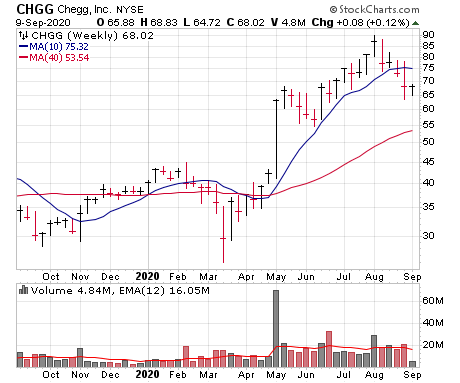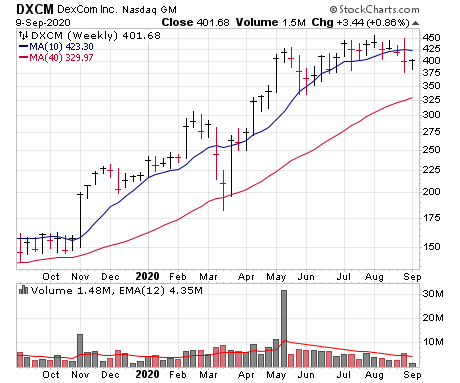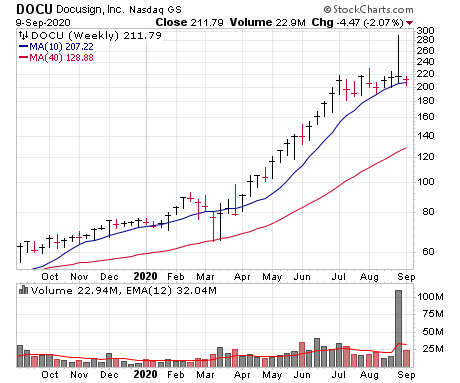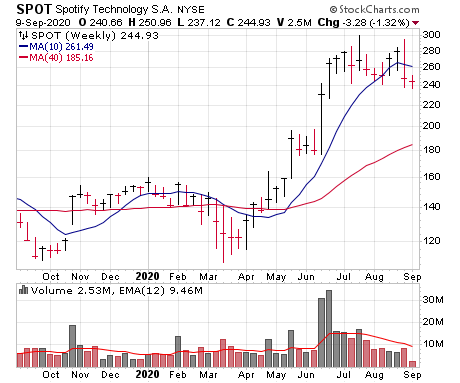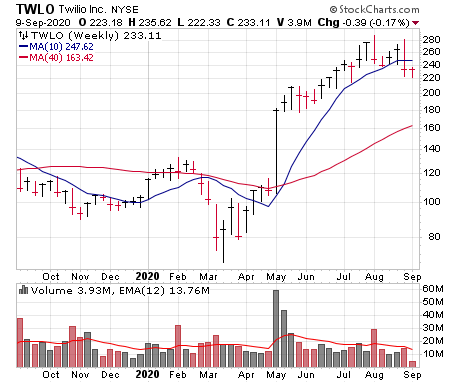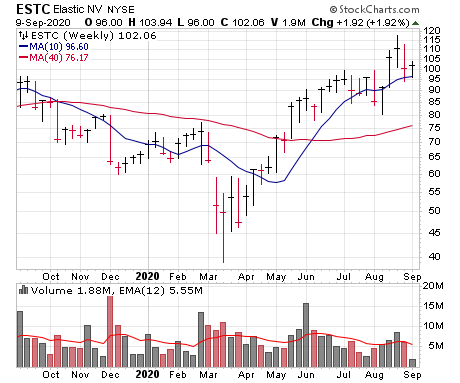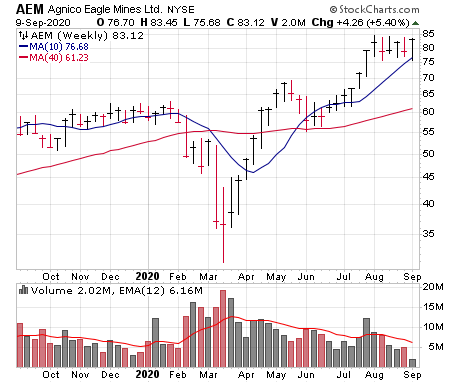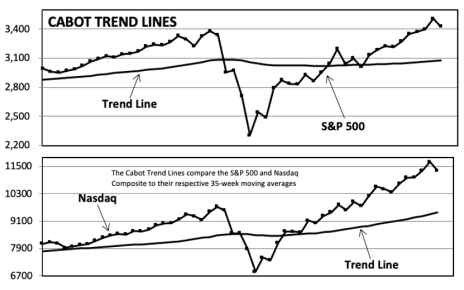Growth stocks have changed character over the past week, with abnormal action and breakdowns appearing. The good news is that a major top doesn’t appear to be in place; the general market is still hanging in there for now, and the long-term trend of most leaders is still up. But, taking things on a stock-by-stock basis, we’ve pared back a bunch and are actually holding more than half the portfolio in cash. That’s probably too high (we’d like to put some to work in fresher leaders), but we’re content to patiently wait for buyers to support the market.
In tonight’s issue, we review all our stocks, dive into the two main factors to your investment returns and go over many fresher names that could help lead the market’s next upmove.
Cabot Growth Investor 1454
[premium_html_toc post_id="214750"]
Burden of Proof is On the Bulls
At heart, we’re students of the market, which means one of the key tools we use is spotting the difference between normal, run-of-the-mill action and abnormal, noteworthy action, the latter of which is what usually causes us to make moves. This abnormal action can occur on both sides of the equation—in April and May, for instance, we wrote about the gaggle of growth stocks that took flight after earnings, which is almost always a bullish sign.
But last week, intermediate-term abnormal action appeared in the opposite direction, at least for growth stocks, with many being rejected at prior highs on big volume, breaking 50-day lines and/or showing massive-volume reversals after huge early-week gains (“icebergs” on the weekly chart—see our writeup on DocuSign inside for more on that). Just as important, these breaks came after prolonged runs (five months up in the market and many stocks) and, for some key leaders, some climactic upside action.
Taking things on a stock-by-stock basis, we cut bait on a few names, which combined with our healthy cash position coming into the decline (25% or so), has resulted in us having more than half the portfolio on the sideline!
So that means we think this is the front edge of a huge correction, right? Not exactly. First off, while growth stocks did yank down everything for a few days, the general market didn’t crack—our Cabot Tides are still bullish (there’s not much wiggle room, but positive is positive) and the broad market is in similar shape.
Second, even among growth stocks, we certainly haven’t seen February 2020-type (read: major market top) action, where everything imploded. Many names are still clinging to some support, and even among those that broke down, the longer-term trends are intact. Indeed, we’re not having too much trouble putting names on our watch list that are still in decent shape.
However, when you lay out all the evidence that’s out there concerning growth stocks, we think the burden of proof is on the bulls to show that this is “just” a short-term shakeout—or possibly a rotation out of some of the initial leaders and into some of the fresher ones (nearly all the names on our watch list are in the latter category).
But that doesn’t mean we want to stay in our storm cellar—in fact, we’d like to put some of our cash to work in a couple of those fresher leaders, and if the buyers can stabilize the situation a bit longer (as they’ve done for the past two days), we may do so.
What To Do Now
Tonight, though, we’ll stand pat, as the Model Portfolio remains in very good shape for the year (handily outpacing the major indexes) and the evidence for growth stocks is iffy at best. Since the last issue, we’ve sold four stocks and are sitting on 55% cash—we’ll be on the horn if we have any changes (buy or sell) in the days ahead.
Model Portfolio Update
After five months of strong gains, the rug was pulled out from under most growth leaders late last week and early this week—the recent bounce has been welcome, but overall, we’re still seeing a lot of charts that have broken down in the intermediate-term.
Taking things on a stock-by-stock basis, we pruned pretty quickly as some names (like DocuSign) flashed climactic action while others cracked mental stops and key support. That’s left us with a whopping 55% in cash—frankly, we think that’s too high given the current crop of evidence. Thus, we’re likely to give our remaining stocks some extra rope, and we may put a little cash back to work if opportunities arise; we actually see a few that are tempting to enter should the recent bounce hold.
Still, given that we just ran up for five months, it’s likely leaders need more than a few days of correcting before resuming their overall advance. Thus, we’re open to new buying, but want to see buyers show some real strength following the decisive breakdowns of last week.
Current Recommendations
| Stock | No. of Shares | Price Bought | Date Bought | Price on 9/10/20 | Profit | Rating |
| Chegg (CHGG) | — | — | — | — | — | Sold |
| Cloudflare (NET) | — | — | — | — | — | Sold |
| Dexcom (DXCM) | 290 | 216 | 11/15/19 | 390 | 81% | Hold |
| DocuSign (DOCU) | — | — | — | — | — | Sold |
| Okta (OKTA) | — | — | — | — | — | Sold |
| ProShares Ultra S&P 500 (SSO) | 2,612 | 60 | 5/29/20 | 73 | 21% | Buy |
| Roku (ROKU) | 548 | 170 | 8/28/20 | 159 | -6% | Buy a Half |
| Spotify (SPOT) | 333 | 279 | 8/28/20 | 248 | -11% | Hold a Half |
| Twilio (TWLO) | 553 | 174 | 5/8/20 | 231 | 33% | Hold |
| Wingstop (WING) | 1,313 | 128 | 6/19/20 | 135 | 5% | Hold |
| CASH | $992,258 | 55% |
Chegg (CHGG 66)—Chegg has always been a squirrelly stock, and maybe that’s all that’s happening here, but we’re not so sure—the stock’s 30% top-to-bottom correction took away most of its post-gap gains since May, and it’s shown no ability to bounce during the past few weeks, either. Of course, it’s hard to deny that there will be more learning/tutoring from home going forward than there was in recent years, yet the question is how much of that ends up falling to Chegg’s bottom line; analysts see earnings up “just” 22% next year, and while that’s probably lowballed, it might not be enough for a stock that trades at 59 times earnings. Bottom line: We took partial profits a couple of weeks back, and as CHGG broke support, we got out a bit above breakeven on the rest last week. SOLD.
Cloudflare (NET 34)—We doubt Cloudflare’s overall run is over—as a relatively new issue with a unique network offering that’s tailormade for the cloud age, it should grow solidly for years and attract a steady stream of new investors over time. But we also have to deal with the here and now, and NET began stalling out in early July (before many leaders), was unable to bounce after getting hit on earnings and came unglued last week, falling nearly 30% off its highs and creating a bunch of overhead resistance. We’ll keep an eye on NET; a setup in the months ahead (it will probably take a while) would be interesting. But we raked in the rest of our solid profit (north of 30%) last week. SOLD.
Dexcom (DXCM 390)—DXCM broke some near-term support on a pickup in volume last week, which obviously isn’t ideal. Still, we don’t view the action as abnormal (still basically in the same range as the past three months), and the fact that shares had been cooling off for a while means fewer weak hands are in. (That’s probably part of the reason the stock is “only” 13% off its peak.) Our leash isn’t limitless (a drop to 340 would likely be as far as we’d go), but we remain optimistic that DXCM’s consolidation since mid-May is a pause that refreshes; if anything, demand for this firm’s G6 (and eventually G7) glucose monitors should accelerate as more and more people head to the doctors like normal, so even the bullish earnings estimates (up 41% this year and 25% next) are likely quite conservative. If you have a solid profit, hang on. HOLD.
DocuSign (DOCU 206)—DocuSign was a great winner for us, but we pulled the plug on the rest of our position after earnings last week. Not that our decision had anything to do with the firm’s results—sales growth accelerated to 45% and earnings of 17 cents were up from a penny a year ago. However, the weekly chart now has a big red flag: Last week is what’s known as an “iceberg,” a dramatically huge weekly bar that (a) comes after a huge run, (b) finishes at the bottom of the range and (c) takes place on monstrous volume, indicating that, after a prolonged move, big investors bailed out in droves when the stock spiked higher, marking a change in character. Of course, 2020 is the rule breaker year, so maybe DOCU can right itself with a little rest. But we like to stick with the odds, and it’s far more likely than not that shares are going to need a long rest (if not a much deeper correction) as money moves elsewhere. All told, DOCU boosted the portfolio by about 13% all by itself in less a year—we’ll take it. SOLD.
Okta (OKTA 198)—Of all the stocks we’ve sold recently, Okta looks the best of the bunch, only 12% off its high and still clinging to the low end of its two-month range. However, we decided to pull the plug for a couple of reasons. First, the stock tried three times to overcome the 220 to 230 range and failed, with the most recent rejection leading to some big-volume selling—usually a reliable sell signal. And second, other new-age cybersecurity stocks (ZS, CRWD) are acting a bit stronger. If you still own OKTA and want to use a stop in the 185 area, we won’t argue with that. But given the factors above and the action among all growth stocks, we took the rest of our profit (34% gain) last week and are looking for greener pastures. SOLD.
ProShares Ultra S&P 500 Fund (SSO 73)—Leading growth stocks have been hit, but the overall market isn’t in bad shape—the S&P 500 fell about 7%, but it (and SSO) held above its 50-day line and has bounced a bit since. Stepping back from the recent mayhem, nothing out there has us worried about the market’s long-term health: Both of our trend-following indicators are still bullish (though the Tides are close to the fence), the blastoff indicators from late May/early June are “only” three-ish months old (you usually don’t see any real issues until at least a year after these flash) and even damaged leading stocks aren’t showing big-picture red flags. Of course, anything is possible in 2020; we’re not stubborn in our outlook. But all signs point to this being a bull market, and that means we’ll see higher prices as time goes on. If the Tides turn negative, we could take partial profits, but right here we think it’s OK for new buyers to step in to SSO here. BUY.
Roku (ROKU 159)—We’re still optimistic ROKU can do very well if the market can right itself. The long-term story hasn’t changed at all (the company is the top platform for connected-TV and streaming video users) and there’s little doubt that the pandemic is accelerating the movement in that direction both for consumers (some see the firm’s active subscribers doubling or tripling during the next few years) and, importantly, for advertisers—more spending that typically goes to linear (regular broadcast) TV may be starting to shift toward connected-TV platforms like Roku, which could be a bonanza. The stock got yanked lower with everything else recently, but volume on the decline was much lighter than the prior upmove and shares have held their 50-day line. If you don’t own any, you can pick up a half position around here. BUY A HALF.
Spotify (SPOT 248)—Looking at the weekly chart, we don’t think SPOT’s overall action is abnormal—the choppy consolidation of the past few weeks hasn’t taken back much of the prior rally. Fundamentally, there are always some worries about competition, but the online music and podcast industry is gigantic, and Spotify is definitely the leader. Given all of that, we want to do our best to hold onto our shares. The trick is our entry point, which came right before the growth stock collapse; being up around 279, we don’t have all that much wiggle room; a 15% drop would be down in the upper 230s, though we could give it a bit more rope as we already have a lot of cash (and we only own a half position remember). Right here, we’re sitting tight as we see how well this bounce will be. HOLD.
Twilio (TWLO 231)—TWLO has hit the toboggan slide along with every other growth leader of late, but we’re aiming to hold through what should be a new launching pad. Obviously, there’s a chance that might not happen, but we continue to think Twilio is unique in that it’s right at the heart of the dramatic movement of everything going online—even many “virus winners,” including Zoom and Peloton, are actually Twilio customers and are expanding their usage; both signed up for Twilio’s email offerings in Q2 so that marketing and messages are received by customers as needed. It’s a similar story for the company’s cloud-based contact center offering (dubbed Flex), which is gaining in popularity for contact tracing (New York and New Mexico) and by all sorts of firms that are moving customer service departments online. PLus, Twilio isn’t just a virus play—many of its customers are in afflicted sectors (travel and hospitality), so as those recover, it should provide an added boost. Like everything else, we won’t just hold and hope; a drop into the 210 area (give or take) would be about as far as we would go. But having sat through two selling waves already (early August and early September), we’re content to practice patience. HOLD.
Wingstop (WING 135)—There’s no way to sugarcoat it: Wingstop has been disappointing. Despite its reliable growth story (retail cookie cutter, aiming to be a top 10 global restaurant brand with a long track record of success) and ability to do well with (best-in-class digital operation) or without pandemic headwinds, the stock got hit hard, plunging have plunged more than 20% right from their high and easily slicing the 50-day line. Still, the stock has a history of occasionally getting tossed around (it can trade thinly at times), and today’s rebound was a good first step, though as always, the strength of the bounce will be telling. We’ll keep WING on a tight leash and see if the stock can continue to lift. HOLD.
Watch List
- DraftKings (DKNG 43) and Penn National Gaming (PENN 62): Both PENN and DKNG look like the odds-on favorites to lead the iGaming and online sports betting movement. See later in this issue for more on PENN and that area.
- Elastic (ESTC 102): Elastic looks like a new-age Big Data firm that’s trying to emerge from huge IPO base. See more below.
- Five Below (FIVE 128): Five Below is an old favorite that may be getting going again after two years in the wilderness. See more below.
- Pinterest (PINS 35): We continue to stalk PINS, which is now six weeks into a choppy rest period just south of all-time highs.
- Trupanion (TRUP 71): TRUP is a bit thin for us, but it has a solid, reliable story—health insurance for pets—that is niche but growing steadily (revenues up between 25% and 28% each of the past five years!), and the stock is very strong.
- Zillow (Z 83): Z’s recent wobbles have been reasonable, though we admit some housing-related stocks are beginning to look iffy.
Other Stocks of Interest
The stocks below may not be followed in Cabot Growth Investor on a regular basis. They’re intended to present you with ideas for additional investment beyond the Model Portfolio. For our current ratings on these stocks, see Updates on Other Stocks of Interest on the subscriber website or email mike@cabotwealth.com.
Five Below (FIVE 128)—Five Below was a great winner for us back in 2017-2018, and frankly, we thought it would do much more; the stock lifted from a five-year consolidation in late-2017 but ended up petering out just a year later. Why? Because underlying conditions changed: The tariff/trade war was heating up, which hiked the firm’s costs and boosted uncertainty, and that of course was followed by the widespread shut-ins due to the virus. But while both issues still exist, they’ve shown improvement (all of the firm’s stores have now reopened), and it looks like the overall story is back on the track. Five Below is a different kind of dollar store, offering all sorts of goodies (from sports to clothes to headsets to candy to decorations and more) for teens and pre-teens—all for $5 or less. It’s a unique niche that few traffic in, which is one of the reasons it has amazing store economics in normal times (a new store pays back the initial investment in less than a year!), which in turn has allowed for a rapid expansion in the store base (generally 15% to 20% a year, though this year, more like 12% due to virus-related delays) and rapid, reliable growth. Near-term, there’s optimism as last week’s quarterly report was encouraging, with same-store sales growth of 6% last quarter and similar rates so far this quarter. Plus, long-term, management believes it can increase the store count by two and a half-fold, so the earnings power here is big even after the initial post-virus ramp that’s expected (earnings next year are forecast to be 25% above 2019’s tally). Thus, the story and numbers look great, and after two years spent chopping and sliding, the chart may be finally be changing character: FIVE rallied nicely off the March lows, then tightened up for nearly three months before pushing higher after earnings last week. It’s not completely free and clear, but FIVE is on our watch list.
Elastic (ESTC 102)—Patience is a virtue in the stock market, especially with IPOs, which can often set up for months or years before finally making their move. That could be the case with Elastic, which appeared to be getting going before the market threw a fit late last week. Elastic dubs itself as a search company, but it’s not a direct Google competitor (though it does do good business in enterprise search); if anything, the firm strikes us as a new-age Big Data company, with software that can ingest and store data (structured or unstructured) from any source, in any format, and allow clients to search, analyze and visualize any way they want in the snap of a finger. Elastic’s offerings help power ride-sharing apps (locating nearby riders/drivers), provide e-commerce suggestions (based on prior buying habits), analyze website and network performance and security (logging billions of events daily) and more, and they work in all sorts of environments; interestingly, this isn’t a cloud firm necessarily, though cloud-related revenue is soaring (up 86% in the last quarter). The use cases are nearly limitless, and indeed, Elastic has been growing like a weed, with revenues up between 53% and 60% each of the past four quarters, while the customer count (up 38%) and same-customer revenue growth (north of 30%) look great. (Earnings are in the red but free cash flow is positive.) This seems like the kind of durable software story that big investors can sink their teeth into, and after basing out for a year and a half after its IPO, ESTC wants to get going—after a five-week pullback in July/August, the stock roared to all-time highs on big volume before pulling back with the market in recent days. Once the pressures come off growth stocks, we think ESTC has a chance to be one of the new leaders.
Agnico Eagle Mines (AEM 82)—We mentioned the gold group in late July (“There’s No Fever Like Gold Fever”), but like many hot areas, it began to cool off in August as it digested a big run. Now many in the group look like solid risk-reward bets, and one of our favorites is Agnico Eagle, a mid-sized gold producer (eight mines, including five in Canada, two in northern Mexico and one in Finland) that had a big CapEx spending wave in recent years that’s now tapering off at the perfect time; with spending coming down while gold prices are high, margins and free cash flow are beginning to surge. Of course, COVID shuttered some mines for a time, but the damage was limited (sales were up 6% and earnings up 80% in Q2) and the future is bright; the second half should see a sharp rebound in production as operations return to normal (Agnico’s overall production should fall less than 5% this year) with next year’s output likely to rise more than 20%, which, along with the aforementioned CapEx drop-off, should result in surging earnings and cash flow. Analysts see the bottom line up 81% this year and 105% in 2021, and that generally assumes gold prices stay level or fade a bit going forward. AEM ripped to new highs in July, and the past five weeks look like a nice, tight rest period with few signs of selling. We think the path of least resistance remains up.
What’s Your Batting Average and Slugging Percentage?
One of the more best interviews we’ve come across was of William Eckhardt, a trend-following trader who gained notoriety in the 1980s. In New Market Wizards (by Jack Schwager), one of many insightful things he said was that “the problem in a nutshell is that human nature does not operate to maximize gain but rather to maximize the chance of a gain; the desire to maximize the number of winning trades (or minimize the number of losing trades) works against the trader.”
We’re not quite in line with Mr. Eckhardt—we think both the percent of trades you have that end up profitable (which we call batting average) and the size of your winners compared to the size of your losers (slugging percentage) are important. But the underlying point is correct—most investors/traders focus too much of their attention and emotions on whether they’re right or wrong, not whether they made money.
This weekend, we looked back at all the stocks we bought in the Model Portfolio since the start of 2019 and have since closed out. (This doesn’t include the positions we still own.) By our records, there were a total of 30 trades, though that includes a lot of half positions, partial sales and the like—for instance, the initial buy of DocuSign (DOCU) and the numerous partial sells (as well as the final sell last week) all count as one “trade.”
Either way, if you look strictly at the batting average, it’s been solid, though nothing amazing—of the 30 trades, 17 made money, resulting a batting average of 56%. That fits in with our experience: In great environments, we might win 60% of the time, while in choppy, tedious environments, that might drop to 40% to 45%. But over many years, we’ve usually been a bit above 50%.
But the profits go back to what Mr. Eckhardt referred to: We work hard at maximizing gains, which means our winners tend to be much larger than our losers. Looking back at the last 20 months of buys and sells and adjusting for position sizes (half positions were half as damaging/rewarding as full positions), the average losing trade cost us about 0.8% of equity—that is, in an account worth $100,000, the average losing trade lost $800-ish.
However, during this time, the winning trades were much larger—on average, each winner resulted in a gain of nearly 2.9% of equity ($2,900 on a $100,000 account). In other words, the average success brought in about three and a half times more money than the average failure took out.
Back to the bigger picture, both batting average and slugging percentage are important, but as Mr. Eckhardt said, you want to avoid thinking too much about trying to be right all (or a very high percentage) the time. What counts is making money, and while you shouldn’t ignore risk (we like to take partial profits here or there on the way up), it’s important to try to develop some bigger winners that can really make a difference in your portfolio.
A New Leading Theme: iGaming and Sports Betting
Oftentimes you’ll find big winning stocks in “old” industries that are being shaken up with a new concept. That’s starting to happen in one of the oldest industries—gambling—thanks to the adoption (and approval by an increasing number of states) of online casino and sports betting.
We’ve written a couple of times about DraftKings (DKNG), which should capture a healthy share of these markets in the years ahead, and whose stock is still building a nice launching pad. It’s worth watching.
A more diversified play is Penn National Gaming (PENN), which is a bigger player in the overall gaming sector, owning 42 properties in over a dozen states that are slowly getting back toward normal as states reopen.
But the real attraction here is Penn’s online ventures. It’s developing an online casino whose app should be very popular with its 20 million rewards members, while the firm’s investment in privately-held Barstool Sports could be a game changer—Penn is producing a Barstool-branded mobile sportsbook app, which should be very attractive to that firm’s 66 million unique monthly visitors, 62% of which (!) bet on sports. The sportsbook app will be launched next week in Pennsylvania, with rollouts in other states in the months ahead.
As for the stock, PENN broke out after earnings in early August, ran higher, handled itself well during the market’s selling wave and popped to new highs today. Both PENN and DKNG are on our watch list. WATCH.
Cabot Market Timing Indicators
The long-awaited pothole has arrived, and for growth stocks, it’s been a doozy—though for the market as a whole, it hasn’t been too bad. We think the onus is on the bulls to step up to the plate, but with our trend following indicators still positive, you should remain flexible; we could put a little money to work if the buyers step up.
Cabot Trend Lines: Bullish
Our Cabot Trend Lines remain clearly bullish—even after last week’s big reversal, both the S&P 500 (by 11.4%) and Nasdaq Composite (by 19.4%) closed miles above their respective 35-week moving averages, so there remains plenty of daylight for further downside without cracking the overall bull move. We continue to expect higher prices in the months ahead.
Cabot Tides: Bullish
Our Cabot Tides have taken on water but remain bullish, as most of the five indexes we track (including the S&P 400 MidCap) dipped to their lower (50-day) moving averages, but have since found some support and bounced. Thus, the intermediate-term trend is positive, though we’re always on the lookout—another selling wave could crack the uptrend (there’s not much daylight left), but we never anticipate signals. Right here, the trend is still pointed up.
Cabot Real Money Index: Neutral
The weekly money flow report comes out tonight (Thursday), and we’ll be interested to see if the recent selloff has caused investors to rush to the exits. If so, that would be a positive sign, but right now, our Real Money Index remains neutral, with a slow, steady selling of equity funds and ETFs not out of character from what we’ve been seeing in recent months.
Charts courtesy of StockCharts.com
The next Cabot Growth Investor issue will be published on September 24, 2020.
Cabot Wealth Network
Publishing independent investment advice since 1970.
CEO & Chief Investment Strategist: Timothy Lutts
President & Publisher: Ed Coburn
176 North Street, PO Box 2049, Salem, MA 01970 USA
800-326-8826 | support@cabotwealth.com | CabotWealth.com
Copyright © 2020. All rights reserved. Copying or electronic transmission of this information is a violation of copyright law. For the protection of our subscribers, copyright violations will result in immediate termination of all subscriptions without refund. No Conflicts: Cabot Wealth Network exists to serve you, our readers. We derive 100% of our revenue, or close to it, from selling subscriptions to its publications. Neither Cabot Wealth Network nor our employees are compensated in any way by the companies whose stocks we recommend or providers of associated financial services. Disclaimer: Sources of information are believed to be reliable but they are not guaranteed to be complete or error-free. Recommendations, opinions or suggestions are given with the understanding that subscribers acting on information assume all risks involved. Buy/Sell Recommendations: All recommendations are made in regular issues or email alerts or updates and posted on the private subscriber web page. Performance: The performance of this portfolio is determined using the midpoint of the high and low on the day following the recommendation. Cabot’s policy is to sell any stock that shows a loss of 20% in a bull market or 15% in a bear market from the original purchase price, calculated using the current closing price. Subscribers should apply loss limits based on their own personal purchase prices.

